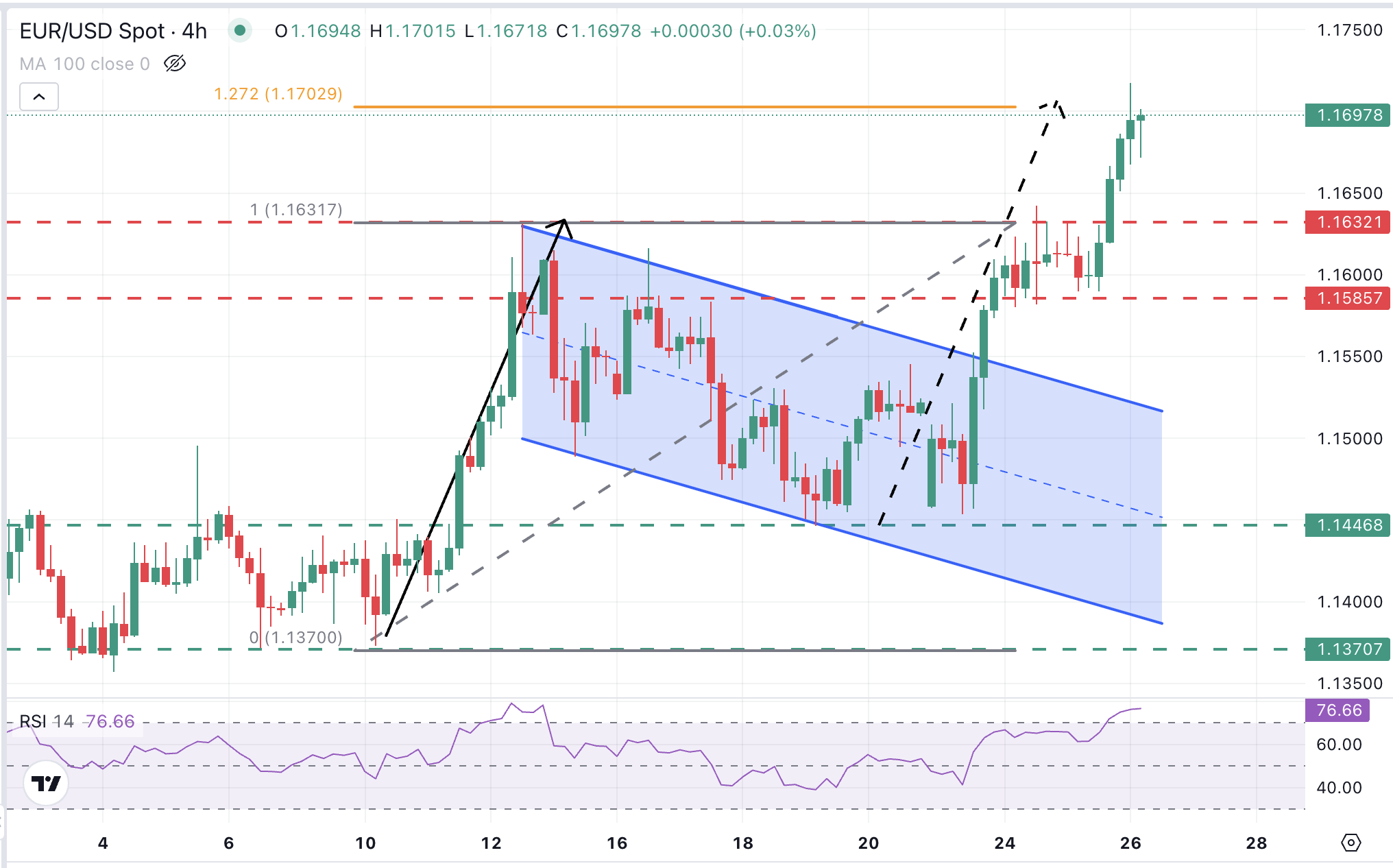Created
: 2025.06.26














![]() 2025.06.26 16:58
2025.06.26 16:58
The EUR/USD appreciates on Thursday for its sixth consecutive day and is trading near the 1.1700 area at the time of writing, at its highest levels since September 2021. News reports that US President Donald Trump is considering an early announcement of the Federal Reserve (Fed) Chair Jerome Powell's successor have rattled markets and sent the US Dollar (USD) tumbling.
A report by the Wall Street Journal suggests that Trump is considering announcing the name of Jerome Powell's replacement in September or October. This would be an unusual move, as Powell ends his term next May, and would create a shadow Fed Chair and undermine the central bank's credibility.
This news comes after Powell reaffirmed his cautious tone regarding further interest rate cuts in his semiannual testimony to Congress, which triggered the umpteenth attack from President Trump, calling him "terrible" and flagging that he has "three to four" candidates to replace him.
With geopolitical tensions out of the foreground, as the truce between Iran and Israel holds for its third day, Trump's erratic trade policy is back in focus. The July 9 deadline approaches, and there is no sign of progress on trade deals with key partners. This is another source of negative pressure for the US Dollar.
The US economic calendar is busy today with May's Durable Goods orders and the final reading of the first quarter's Gross Domestic Product (GDP) grabbing the focus. The highlight of the week, however, will be Friday's Personal Consumption Expenditures (PCE) Price Index. This is the Fed's inflation gauge of choice and will be observed with attention to assess Fed easing expectations.
The table below shows the percentage change of Euro (EUR) against listed major currencies today. Euro was the strongest against the US Dollar.
| USD | EUR | GBP | JPY | CAD | AUD | NZD | CHF | |
|---|---|---|---|---|---|---|---|---|
| USD | -0.37% | -0.50% | -0.69% | -0.16% | -0.37% | -0.24% | -0.37% | |
| EUR | 0.37% | -0.09% | -0.35% | 0.23% | 0.04% | 0.14% | 0.01% | |
| GBP | 0.50% | 0.09% | -0.28% | 0.32% | 0.12% | 0.24% | 0.10% | |
| JPY | 0.69% | 0.35% | 0.28% | 0.55% | 0.36% | 0.45% | 0.34% | |
| CAD | 0.16% | -0.23% | -0.32% | -0.55% | -0.20% | -0.17% | -0.22% | |
| AUD | 0.37% | -0.04% | -0.12% | -0.36% | 0.20% | 0.02% | -0.02% | |
| NZD | 0.24% | -0.14% | -0.24% | -0.45% | 0.17% | -0.02% | -0.05% | |
| CHF | 0.37% | -0.01% | -0.10% | -0.34% | 0.22% | 0.02% | 0.05% |
The heat map shows percentage changes of major currencies against each other. The base currency is picked from the left column, while the quote currency is picked from the top row. For example, if you pick the Euro from the left column and move along the horizontal line to the US Dollar, the percentage change displayed in the box will represent EUR (base)/USD (quote).

EUR/USD rallies further on early Thursday trading, favoured by US Dollar weakness, and reaches the target of the previous two weeks' bullish flag formation, right above 1.1700. The fundamental contest remains supportive, but the 14-period Relative Strength Index (RSI) indicator on the 4-hour chart has reached overbought territory, which suggests that a consolidation or even a bearish correction is on the cards.
On the downside, the pair may find support at the previous resistance area near 1.1630 (June 12, 24 highs) ahead of 1.1585 (June 24, 25 lows) and the downward sloping trendline, now at 1.1520.
Immediate resistance is at the 1.1700 area, the 127.2% Fibonacci extension of the June 10-12 rally, and above here, 1.1795, the 161,8% Fibonacci extension of the mentioned move.
Monetary policy in the US is shaped by the Federal Reserve (Fed). The Fed has two mandates: to achieve price stability and foster full employment. Its primary tool to achieve these goals is by adjusting interest rates. When prices are rising too quickly and inflation is above the Fed's 2% target, it raises interest rates, increasing borrowing costs throughout the economy. This results in a stronger US Dollar (USD) as it makes the US a more attractive place for international investors to park their money. When inflation falls below 2% or the Unemployment Rate is too high, the Fed may lower interest rates to encourage borrowing, which weighs on the Greenback.
The Federal Reserve (Fed) holds eight policy meetings a year, where the Federal Open Market Committee (FOMC) assesses economic conditions and makes monetary policy decisions. The FOMC is attended by twelve Fed officials - the seven members of the Board of Governors, the president of the Federal Reserve Bank of New York, and four of the remaining eleven regional Reserve Bank presidents, who serve one-year terms on a rotating basis.
In extreme situations, the Federal Reserve may resort to a policy named Quantitative Easing (QE). QE is the process by which the Fed substantially increases the flow of credit in a stuck financial system. It is a non-standard policy measure used during crises or when inflation is extremely low. It was the Fed's weapon of choice during the Great Financial Crisis in 2008. It involves the Fed printing more Dollars and using them to buy high grade bonds from financial institutions. QE usually weakens the US Dollar.
Quantitative tightening (QT) is the reverse process of QE, whereby the Federal Reserve stops buying bonds from financial institutions and does not reinvest the principal from the bonds it holds maturing, to purchase new bonds. It is usually positive for the value of the US Dollar.
![]()
Created
: 2025.06.26
![]()
Last updated
: 2025.06.26

FXStreet is a forex information website, delivering market analysis and news articles 24/7.
It features a number of articles contributed by well-known analysts, in addition to the ones by its editorial team.
Founded in 2000 by Francesc Riverola, a Spanish economist, it has grown to become a world-renowned information website.
We hope you find this article useful. Any comments or suggestions will be greatly appreciated.
We are also looking for writers with extensive experience in forex and crypto to join us.
please contact us at [email protected].
Disclaimer:
All information and content provided on this website is provided for informational purposes only and is not intended to solicit any investment. Although all efforts are made in order to ensure that the information is correct, no guarantee is provided for the accuracy of any content on this website. Any decision made shall be the responsibility of the investor and Myforex does not take any responsibility whatsoever regarding the use of any information provided herein.
The content provided on this website belongs to Myforex and, where stated, the relevant licensors. All rights are reserved by Myforex and the relevant licensors, and no content of this website, whether in full or in part, shall be copied or displayed elsewhere without the explicit written permission of the relevant copyright holder. If you wish to use any part of the content provided on this website, please ensure that you contact Myforex.
Myforex uses cookies to improve the convenience and functionality of this website. This website may include cookies not only by us but also by third parties (advertisers, log analysts, etc.) for the purpose of tracking the activities of users. Cookie policy